Preprint
Article
Development and Validation of Correlation Charts to Predict the Undisturbed Ground Temperature of Pakistan; a Step Toward Potential Geothermal Energy Exploration
Altmetrics
Downloads
165
Views
88
Comments
0
A peer-reviewed article of this preprint also exists.
This version is not peer-reviewed
Submitted:
21 April 2023
Posted:
21 April 2023
You are already at the latest version
Alerts
Abstract
Pakistan relies mostly on fossil fuel for fulfilling its energy demand which is expensive as 11 well as not friendly for the environment. The need of the hour is to shift from fossil fuels to renew-12 able energy resources like geothermal, wind, solar etc. to cater for global warming issues. Pakistan 13 has a lot of potential geothermal sites because of several fault lines and hot springs. A sound 14 knowledge of ground temperature is essential to use geothermal energy, which is obtained by drill-15 ing boreholes and putting sensors making it an expensive procedure. Thus, to avoid huge cost for 16 drilling bore holes, particularly for ground temperature analysis, a numerical approach has been 17 considered for determining ground temperature. Furthermore, correlation charts between air and 18 ground temperatures have been developed as there were no proper studies on the ground temper-19 ature of Pakistan. Then, with the help of a boreholes drilled in National University of Sciences and 20 Technology Islamabad Pakistan, the actual ground and numerically calculated temperatures have 21 been compared which shows an error margin in the range between 0.27% for higher depths to 7.3% 22 near surface. Thus, it is shown that the proposed method is easy to implement and better than large 23 scale testing methods for the depths at which geothermal energy is extracted.
Keywords:
Subject: Engineering - Civil Engineering
1. Introduction
Sustainability is the primary goal of the global energy market and responsible consumption of natural resources is a dire need of this era according to the United Nations Sustainable development goals [1]. Pakistan is rich in renewable energy resources, still it is facing energy crises like shortage of electricity and load shedding [2,3]. Also, to generate electricity it imports fuel which is a huge hindrance to its economic development. The conventional energy sources like coal, gas, diesel, and fossil fuels are on the verge of ending and Pakistan needs to consider alternate and sustainable renewable energy sources [4]. The conventional methods are hazardous to the environment due to the release of ozone depleting and greenhouse gases (GHG). These two phenomena are mostly responsible for global warming and climate change, thus causing extreme weather conditions, glacier melting and flooding [5,6]. On the other hand, renewable sources like wind, hydro and geothermal energy are clean energy technologies which produce less GHG and are environmentally friendly and a counter measure for global warming to fulfill energy demands [7,8,9]. Pakistan has a lot of geothermal potential due to its geology which can be harvested for energy purpose. This research discusses the potential of geothermal energy in Pakistan where all the energy resources are being used for energy generation except the geo-thermal energy to cater global warming. The statistics of the available energy sources previously studied illustrate that the energy sources are mainly composed of conventional sources and fossil fuels [10]. Thus, it is becoming very difficult to meet the energy requirements of the country as the prices of fossil fuels are increasing day by day. The average annual energy demand of Pakistan is also increasing at the rate of 8% to 10% annually [11]. The board of investment Pakistan gives the figure of 22,797 MW as the installed power capacity. But the generation stands approximately between 12,000 MW and 13000 MW per day [12]. The China Pakistan Economic Corridor (CPEC) is opening ways for investors in Pakistan increasing the energy demand abruptly. These commercial enterprise ventures can be powered by the energy generated by themselves using geo-thermal energy.
Pakistan is located within the latitude and longitude of 30.37° N, 69.34° E with a land of about 800,000 km2. The northeast to southwest extent of the country is about 1700 km, and its east–west width is approximately 1000 km. The geomorphology of Pakistan varies from lofty mountains of Himalayas, Karakorum, Hindukush, and Pamirs in the north to the fascinating coastline of the Arabian Sea in the south. In between the northern and southern extreme ends of the country, notable, and unique bended north–south oriented mountain ranges exist centrally bounded by the fertile plains of 3000-long River Indus and western part of famous Thar Desert on eastern side, and by the Chagai volcanic arc, vast tectonic depression of Kharan, and the westward swinging mountain ranges of Makran flysch basin. Pakistan is a huge museum of Geological formations with a variety of rocks and formations. Pakistan’s geothermal energy resources are located in the following four regions: Northern Pakistan consisting of Gilgit Baltistan, Northwestern and South Baluchistan, Indus Basin and West Sindh, Southwestern & Northern Punjab [13]. The sources, location and outlet reservoir temperature of some of the geothermal springs in Pakistan are Murtazaabad Springs in Hunza (237 oC), Budelas Valey Springs in Hunza (159 oC), Dasu Springs in Kohistan (200 oC), Tatta Pani in Astore (200 oC), Sassi in Skardu (200 oC), Karsaz Spring in Karachi (70 -145 oC), Manghopir Spring in Karachi (70 - 145 oC), Kharan and Kohe Sultan Spring in Kharan and Chaghi (200 - 300 oC) [13,14]. Besides the regions mentioned, there are other spots as well, where single or multiple geothermal springs exist, and geological survey of Pakistan has issued a list of 12 regions investigated [15]. These regions are blessed with un-tapped geothermal energy resources. The only need is to exploit and utilize them efficiently and responsibly [16]. But the concept of geothermal energy is rare in Pakistan. Furthermore, to determine the geothermal potential, ground temperature data is required but the ground temperature of Pakistan is not studied in detail. Thus, a numerical approach is needed to find out the temperature at higher depths in order to avoid the cost of drilling bore holes and heavy instrumentations to measure ground temperature. By now, it is evident that Pakistan has enough resources to generate and use the Geothermal Energy, but many geothermal potential areas are still unexplored and those which are known are not being used to fulfill the energy needs. Thus, there is dire need to study the geothermal potential and ground temperature of Pakistan in detail.
Literature shows that ground temperature is influenced significantly by the air temperature at lower depths and as the depth below increases, a lag between air and ground temperature is observed such that the ground temperature becomes constant at a particular depth. At this depth, the temperature remains almost the same for the whole year. Thus, the difference between the air and ground temperature is utilized for heating purposes in winter season and cooling in summer season. The greater the difference between air and ground temperature, greater will be the efficiency of the geothermal system installed [17]. It is evident that the heat energy of the earth, stored in the ground, is a renewable source and can be extracted easily through environmentally friendly techniques [18]. Subsurface ground temperature profile is a prominent determinant of various thermo-active and latent heat applications. These include geothermal energy extraction and storage through contact mechanisms with structural elements, heating of airport runways, and the closed systems, using tunnel lining and support, as energy absorbers [19]. Moreover, the Ground Temperature (GT) profile is also being utilized to effectively predict the biological, zoological and pathological life cycle processes that occur underground. These complex activities have their major roots in the earth acting as a fluctuating heat source, with variable vertical temperature distribution and thermal diffusivity, at various times of the year. Geothermal resources are at present mainly used for generating electricity and air conditioning by means of District Heating (DH) and geothermal heat pump systems [20]. These resources are normally classified as renewable energy sources, because they are maintained by a continuous energy current [21]. Geothermal technologies use renewable energy resources to generate electricity and/or heating and cooling while producing very low levels of greenhouse-gas emissions [22,23]. Thus, as a solution of global warming, this research focuses on potential of geothermal energy in Pakistan by mapping its ground temperature at different depths with the help of newly generated temperature correlation charts between air and ground that have never done before for this region. Section 2 discusses the numerical and empirical approach, while section 3 analyzes the temperature chart of respective regions and concludes with discussion at end.
2. Methodology
2.1. Determination of Ground Temperature by Numerical Approach
Kusuda formulated a correlation, in which it was described that ground temperature is a function of depth below the surface and time of the year [17,24]. The thermo-physical properties of soils and rocks make them an excellent propagator of latent heat in the ground. The equation developed by Kusuda is as follows:
Where:
- Tsoil (D, tyear) = Ground Temperature
- Tmean = average surface i.e. air temperature
- Tamp = Amplitude of surface temperature [(max. air temperature – min. air temperature)/2]
- D = Depth below the surface (surface=0)
- α = Thermal diffusivity of the soil
- tyear = current time (day)
- tshift = day of the year of minimum surface temperature
This correlation has been widely used to effectively predict the ground temperature profile, over the term of many decades. The correlation assumes that thermal diffusivity varies with different depths, irrespective of time of the year. The time period can be as short as one day (86400 seconds) to as long as a year (3.1536x107 seconds). Applying this equation for Islamabad Pakistan, the profile of ground temperature Figure 1 is obtained. The ground temperatures were calculated by considering the soil thermal diffusivity equivalent to clay (0.0267 m2/day) because the predominant soil in Islamabad region is clay which is also confirmed by bore logs. The air temperature data was obtained from the Pakistan Meteorological Department (PMD).
2.2. Determination of Ground Temperature by Experimental Approach
Previous studies show that kusuda formula might not provide accurate results everywhere because of different spatial temperature variation and equatorial location [25]. Thus, it is necessary to verify and validate this equation for Pakistan, before its application. The validation of this equation was carried out by comparing its results obtained with the bore hole drilled inside the university, especially for ground temperature measurement purpose. Figure 2 shows the actual ground temperatures. The comparison between numerical results and experimental results shows an error margin in the range between 0.27% for higher depths to 7.3% near surface. Figure 3 shows that the approach works perfectly for depths greater than about 2 m and the error margin decrease as depth increases. At lower depth, the results from field and equation vary significantly. It is because the shallow depths are affected greatly by the surface weather conditions [17].
3. Results
3.1. Temperature Correlation
A/G Charts:
The kusuda formula has been widely used to effectively predict the ground temperature profile, over the term of many decades. However, a very important contemplation of kusuda’s equation is the hypothesis of defining the variation of the ratio of air and ground temperatures with depth as shown in Figure 4 (a, b, c, d) which is the main contribution of the authors. (4 charts are attached here while the rest are put in appendix A). These graphs have been plotted by taking into account the average monthly air and ground temperatures, with uniformly increasing depth. Time interval taken is one complete month, over the course of a complete year. Different types of soils and rocks have been investigated in the postulation of this hypothesis. These include sand (unsaturated and saturated), clay (unsaturated and saturated), silt, peat, gravel, sandy gravel, loam, shale, granite, dolomite, quartz, sandstone and limestone which correspond to meteorologically recorded average monthly temperatures of 11 separate districts, from all across Pakistan. These areas include Rawalpindi, Bahawalpur, Lahore, Multan, Faisalabad, Quetta, Peshawar, Skardu, Jhelum, Zhob and Karachi. These charts have depths on X-axis and A/G (air temperature by ground temperature) ratio on Y-axis. It can be seen that the slope of monthly air/ground temperatures vs. Depth is steeper for the first 2m below the ground. However, it can be observed that the A/G ratio becomes relatively constant, exceeding the depths of 6 m. It is due to the high thermal inertia of the soil, the fluctuations in ground temperature are diminished with higher depths and the ground temperature remains relatively constant [26].
Temperature Mapping of Pakistan:
Resulting soil and rock temperature envelopes, formulated from the annual A/G ratio vs. Depth graphs, have been used to develop a comparison between each soil envelope. Figure 5 shows the resulting annual graphs of each soil and rock, modelled over a period of one year. It can be perceived from the resultant graphs that the A/G vs depth is highest for clay (dry), sand (dry), loam, shale and sandstone for the month of June; silt, gravel, sandy gravel and limestone for the month of July; and dolomite and granite for the month of August. However, lower most temperature fluctuates between winter months of January and December, for all of the different soil and rock types under investigation. It can be inferred from the hypothesis that the ambient temperature of the month under study and resulting ground temperature greatly influences soil and rock temperature envelops, when thermal diffusivities of the said geological materials are kept constant. Figure 6 depicts the work of the authors which used A/G charts for the temperature zoning of Pakistan based on the annual ground temperatures obtained considering the predominant soil type in the mentioned region. The soils type map was obtained from soil survey of Pakistan.
4. Discussion and Conclusions
Geothermal energy is a clean energy technology which plays a key role in reducing greenhouse gases thus giving a solution for global warming while fulfilling the energy needs. The authors discussed the geothermal energy potential of Pakistan and provided a new correlation chart to understand the ground energy in terms of temperature. It is also shown that the type of soil and its characteristics governs the transmission of ground temperature between soil and the structural foundation element. Moreover, the morphological, rheological and geological characteristics of the soil and rock type, greatly affects A/G vs. depth charts. Furthermore, the thermal properties of the material under study are significantly affected by the ground temperature profile. Overall, using the A/G charts is environmentally friendly and inexpensive considering both time and money. The result of the study is concluded as below:
- Ground temperature charts show that type of soils/rocks and its characteristics govern the transmission of ground temperature between soil and the structural foundation element.
- Rock types at a shallow depth have a highly fluctuating A/G temperature profile as compared to the same rock types at higher depths.
- A/G ratio for igneous and sedimentary rocks (Granite and Dolomite) is higher than soil and soft rocks.
- Significant fluctuation of A/G pattern is observed in the case of Dolomite and other sedimentary rocks.
- A/G pattern is similar to that of soils observed in case of Limestone, Sandstone and Shale even though they are sedimentary rocks.
- The geothermal potential of Pakistan is easily conceptualized by using the A/G charts.
For future studies, it is recommended that other cities’ data must also be validated for any inconsistencies, as the bore holes were drilled only in one city. In this way A/G charts made for other cities of Pakistan and zoning done for geothermal potential by considering the ground temperature be more reliable.
Author Contributions
For research articles with several authors, a short paragraph specifying their individual contributions must be provided. The following statements should be used “Conceptualization, T.A. and W.H.; methodology, T.A.; software, T.A.; validation, T.A., W.H. and A.H.; formal analysis, A.H.; investigation, T.A.; resources, A.H.; data curation, T.A.; writing—original draft preparation, T.A.; writing—review and editing, W.H.; visualization, W.H.; supervision, A.H.; project administration, T.A.; funding acquisition, A.H. All authors have read and agreed to the published version of the manuscript.”
Acknowledgments
The authors are thankful to Professor Dr. Jamal Thaheem, Assistant Professor Abdul Jabbar, colleagues (Ahmed Waqar and Muhammad Junaid) for their contributions and suggestions to improve this paper.
Conflicts of Interest
The authors declare no conflict of interest.
Appendix A
 |
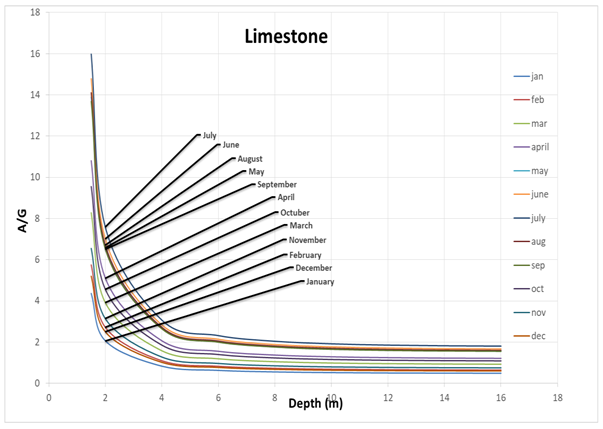 |
 |
 |
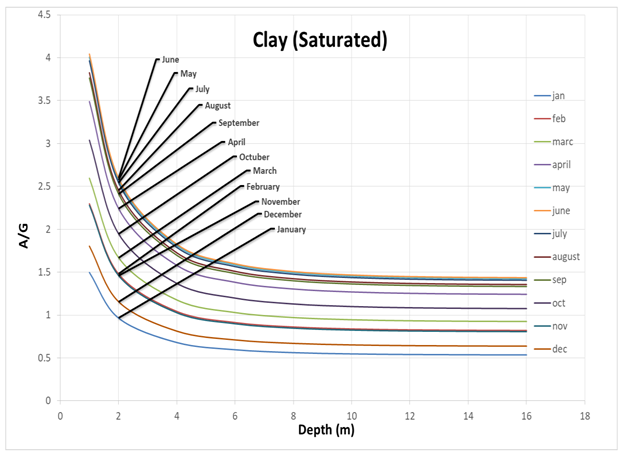 |
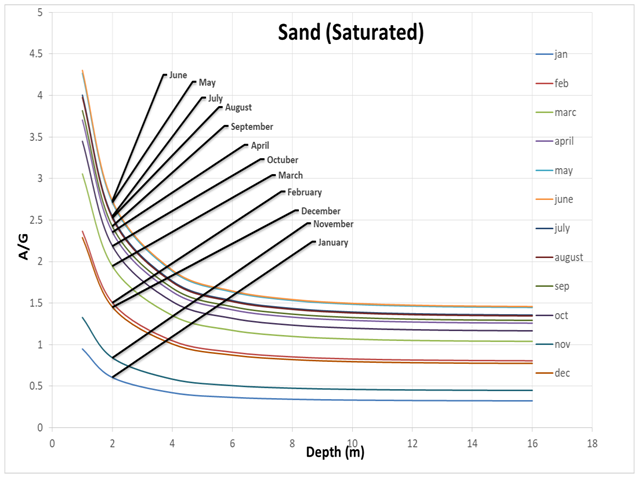 |
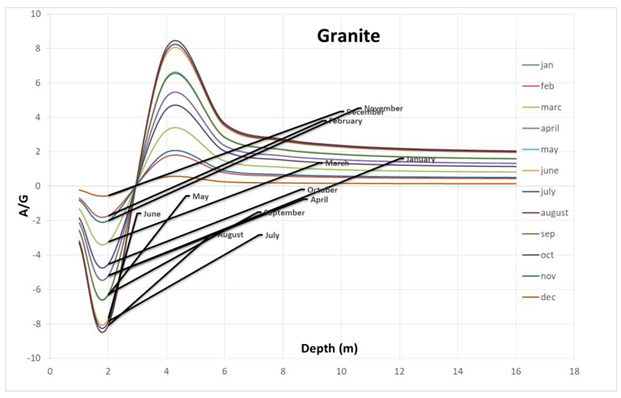 |
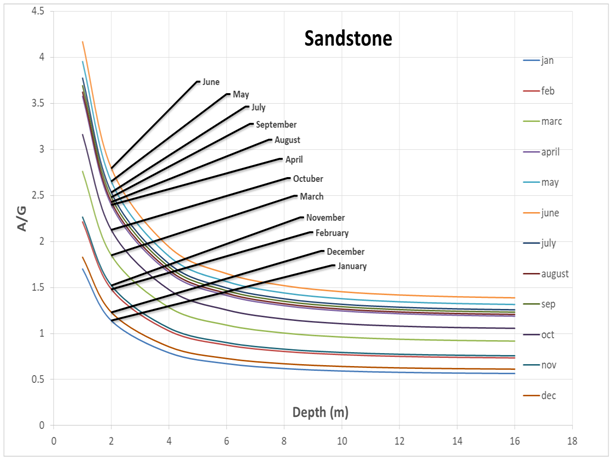 |
 |
References
- Alcaraz M, García-Gil A, Vázquez-Suñé E, Velasco V. Use rights markets for shallow geothermal energy management. Applied Energy 2016;172:34–46. [CrossRef]
- Arshad F, Shamshad M. Energy Crisis in Pakistan: Socio-Economic Implications and the Way Forward. Annals of Social Sciences and Perspective 2022;3:105–15. [CrossRef]
- Ali M, Wazir R, Imran K, Ullah K, Janjua AK, Ulasyar A, et al. Techno-economic assessment and sustainability impact of hybrid energy systems in Gilgit-Baltistan, Pakistan. Energy Reports 2021;7:2546–62. [CrossRef]
- Kalair A, Abas N, Saleem MS, Kalair AR, Khan N. Role of energy storage systems in energy transition from fossil fuels to renewables. Energy Storage 2021;3:e135. [CrossRef]
- Kumari S. Chapter-5 Global Warming: Causes, Effects and Solutions. Emerging Trends in Agriculture Sciences 2021:67.
- Wang LK, Wang M-HS, Wang N-Y, Wong JO. Effect of Global Warming and Climate Change on Glaciers and Salmons. Integrated Natural Resources Management, Springer; 2021, p. 1–36.
- Nautiyal A, Ramlal A. Clean Energy Sources for a Better and Sustainable Environment of Future Generations. Energy: Crises, Challenges and Solutions 2021:151–68.
- Dincer I, Acar C. A review on clean energy solutions for better sustainability. International Journal of Energy Research 2015;39:585–606. [CrossRef]
- Evans A, Strezov V, Evans TJ. Assessment of sustainability indicators for renewable energy technologies. Renewable and Sustainable Energy Reviews 2009;13:1082–8. [CrossRef]
- Farooqui SZ. Prospects of renewables penetration in the energy mix of Pakistan. Renewable and Sustainable Energy Reviews 2014;29:693–700. [CrossRef]
- Khan HA, Pervaiz S. Technological review on solar PV in Pakistan: Scope, practices and recommendations for optimized system design. Renewable and Sustainable Energy Reviews 2013;23:147–54. [CrossRef]
- Farooqui SZ. Prospects of renewables penetration in the energy mix of Pakistan. Renewable and Sustainable Energy Reviews 2014;29:693–700. [CrossRef]
- Hossein S, Bukhari S. Country Update Paper on Pakistan. World Geothermal Congress 2015 2015:7.
- Ahmad M, Rafique M, Iqbal N, Fazil M. Investigation of origin, subsurface processes and reservoir temperature of geothermal springs around Koh-i-Sultan volcano, Chagai, Pakistan. Pakistan Institute of Nuclear Science and Technology; 2009.
- Bakht MS. AN OVERVIEW OF GEOTHERMAL RESOURCES OF PAKISTAN . Bakht. World Geothermal Congress, Khyushu-Tohoku, Japan, May 28-June 10 2000:77–83.
- Ahmad I, Rashid A. Study of geothermal energy resources of Pakistan for electric power generation. Energy Sources, Part A: Recovery, Utilization and Environmental Effects 2010;32:826–38. [CrossRef]
- Florides G, Kalogirou S. Measurements of Ground Temperature at Various Depths. Proceedings of the SET 2004, 3rd International Conference on Sustainable Energy Technologies 2004:1–6.
- Limberger J, Boxem T, Pluymaekers M, Bruhn D, Manzella A, Calcagno P, et al. Geothermal energy in deep aquifers: A global assessment of the resource base for direct heat utilization. Renewable and Sustainable Energy Reviews 2018;82:961–75. [CrossRef]
- Brandl H. Thermo-active ground-source structures for heating and cooling. Procedia Engineering 2013;57:9–18. [CrossRef]
- Manzella A, Bonciani R, Allansdottir A, Botteghi S, Donato A, Giamberini S, et al. Environmental and social aspects of geothermal energy in Italy. Geothermics 2018;72:232–48. [CrossRef]
- Axelsson G. Production capacity of geothermal systems. Proceedings of the Workshop for Decision Makers on the Direct Heating Use of Geothermal Resources in Asia, 2008, p. 14.
- Fridleifsson IB, Bertani R, Huenges E, Lund JW, Ragnarsson A, Rybach L. The possible role and contribution of geothermal energy to the mitigation of climate change. IPCC scoping meeting on renewable energy sources, proceedings, Luebeck, Germany, vol. 20, Citeseer; 2008, p. 59–80.
- Sowizdzal A. Geothermal energy resources in Poland–Overview of the current state of knowledge. Renewable and Sustainable Energy Reviews 2017. [CrossRef]
- Kusuda T, Archenbach P. Earth temperature and thermal diffusivity at selected stations in the United States. ASHRAE Transaction 1965;71:61–75.
- Muhammad IS, Baharun A, Ibrahim HS. INVESTIGATION OF GROUND TEMPERATURE FOR HEAT SINK APPLICATION IN KUCHING, SARAWAK, MALAYSIA. Journal of Civil Engineering 2016;7. [CrossRef]
- Florides G, Kalogirou S. Annual ground temperature measurements at various depths. 8th REHVA World Congress, Clima 2005:1–6. Proceedings of CLIMA 2005, Lausanne, Switzerland.
Figure 1.
Ground temperature at different depths using Kusuda Equation.

Figure 2.
Ground Temperature at different depths from thermometers in the boreholes.

Figure 4.
(a, b, c, d) A/G vs Depth Ground Temperature Correlation charts.


Figure 5.
Ground Temperature envelope for all soils and rocks considered.

Disclaimer/Publisher’s Note: The statements, opinions and data contained in all publications are solely those of the individual author(s) and contributor(s) and not of MDPI and/or the editor(s). MDPI and/or the editor(s) disclaim responsibility for any injury to people or property resulting from any ideas, methods, instructions or products referred to in the content. |
© 2023 by the authors. Licensee MDPI, Basel, Switzerland. This article is an open access article distributed under the terms and conditions of the Creative Commons Attribution (CC BY) license (http://creativecommons.org/licenses/by/4.0/).
Copyright: This open access article is published under a Creative Commons CC BY 4.0 license, which permit the free download, distribution, and reuse, provided that the author and preprint are cited in any reuse.
MDPI Initiatives
Important Links
© 2024 MDPI (Basel, Switzerland) unless otherwise stated






